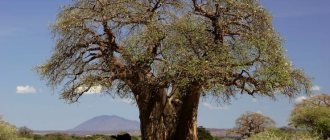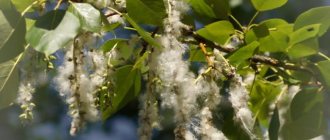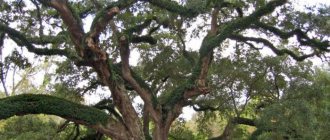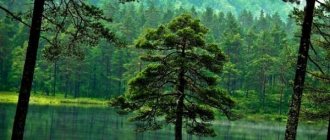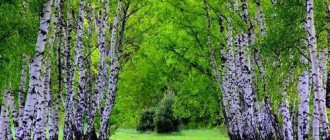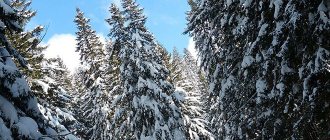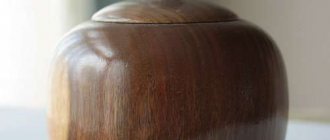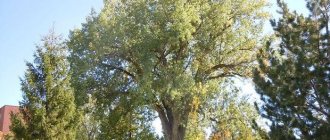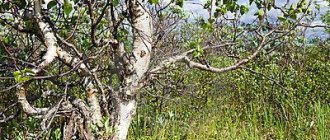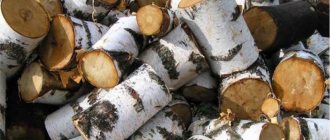Many people who love to relax in nature, walk through the forest or just sit in the park, pay attention to the huge, tall trees. The most common question that arises is how many years trees live. Some of the most beautiful and mysterious are oak and birch groves. Walking past massive oaks or slender and tall birches, do you think how many years do trees live?
How many years do birch, oak and linden live?
When we look up at this or that tree, we don’t think about how much it has already seen in its lifetime.
But sometimes the question still pops into my head about how long it has been standing here. And in general, how many years do trees grow or live? After all, not only humans or animals were assigned their own “limit” of stay on Earth. Each tree has a certain life expectancy. But you can go through their varieties and types endlessly, so let’s try to answer the question regarding the most common trees: birch, oak and linden. How long do they live?
Fastest growing tree
The fastest growing tree on planet Earth is the eucalyptus, native to Australia and the island of Tasmania.
In the first 10 years of its life, this tree grows very quickly, increasing in height by 4-5 meters annually.
By the age of a century, eucalyptus reaches a height of 100 m.
The growth rate of this plant is 4 times higher than that of oak, and 5-year-old eucalyptus plantations are already real forests. These trees grow only in tropical and subtropical climates.
Birch
A primordially Russian beauty, praised in songs, mentioned in proverbs and Russian folk tales. But it grows not only in our vast expanses; you can find birch in American and Chinese forests. The slender tree is easy to recognize by its color: the white bark is crossed by black stripes.
In early spring, when the buds are just beginning to swell on most trees, birch trees are already covered with the first green leaves. In two weeks, the birch forest turns from a gloomy forest into a colorful grove.
How many years does a birch tree live?
Here it is worth noting the fact that it is difficult to reliably answer this question: it is impossible to keep track of the second, tenth or hundredth tree. In addition, birch has many different species and subspecies , each of which has a number of external features and its own life expectancy.
The Karelian birch, known to many, lives for a relatively short time, compared to other trees: only 30-50 years.
But its common “relative”, drooping or warty , is capable of living up to 120. But along with them, there are also centenarians, whose age dates back to the fourth, or even the fifth century.
If we talk about “average” values, they fluctuate around 100–300 years. But this is not the limit: during all this time, the birch tree is diligently developing, stretching in height and growing long branches. And when growth stops, the movement of nutrients in the trunk begins to gradually slow down - in this state the tree can live for more than one year.
Nowadays it is not so often possible to find an oak grove in Russia. But if you happen to visit one, you will immediately realize all the mystery and majesty of these trees. Maybe they don’t sing songs about them, but they make up legends. Oak is the personification of strength, wisdom and longevity.
It grows mainly in
areas located in the northern hemisphere .
Starting its journey as a small and slender tree, over the years the oak acquires its inherent massiveness: the spreading crown can reach 40 meters in height, and the circumference of already “established” trunks is 9 meters, which is also quite a lot. The tree is also known for its healing properties: a decoction of oak bark has good anti-inflammatory properties and is used in folk medicine. And acorns are an excellent component for relieving spasms, swelling and inflammation.
How many years does an oak tree live?
This tree is one of the longest living . And it’s not easy - oak can survive fire and water, reaching up to two thousand years! But it’s worth making a reservation: the average life expectancy of one of the “representatives” of the oak forest ranges from 300 to 450 years. And only under favorable conditions these years can stretch for tens of centuries.
During the first 100-150 years, the oak tree actively develops, blooming only by 20 or even 30 years. But the diameter of its trunk increases throughout its life, becoming overgrown with new layers of bark.
There are two particularly old and therefore remarkable trees on the planet:
- The Mamre oak has been growing in Palestine for almost two thousand years. It is so old that even in the Bible there is a mention of it: once upon a time, it was under this tree that Patriarch Abraham accepted God.
- And in Lithuania you can find the Stelmuzh oak - the oldest tree in all of Europe. If you believe the sources that mention him, he is at least a century older than his sacred “comrade.”
The oldest trees
Pine: what it looks like and how many years it lives, pros and cons
As already mentioned, today there are about 600 species of oaks in the world. Each species is unique, differs in both size and appearance, and most importantly, life expectancy. Of course, it is not possible to list and talk about all types of oak, but it is possible to mention the oldest trees.
Let's get acquainted with long-lived oaks that amaze people with their size and age. It should be noted that some of the oldest trees are still growing and functioning, but others live in legends, tales and stories of our ancestors.
Mamvrian
This is the oldest oak tree known today. Its homeland is the Palestinian Authority in the city of Hebron. Scientists have determined that its age is approximately 5 thousand years.
The history of the Mamre oak dates back deeply to biblical times. There are many biblical stories associated with this giant. It was under this tree that the meeting between Abraham and God took place.
Since this giant is often mentioned in the Bible, people have been looking for it for a long time and wanted to profit from it. In the 19th century, the oak was found by the clergyman Anthony, which belonged to the Russian Orthodox Church. Since then, this miracle of nature has been constantly looked after.
People formed an opinion, which over time began to be called a prophecy. There is such a belief: when the “Mamvrian giant” dies, the apocalypse will come. In 2022, a terrible thing happened - a tree that had been drying out for a long time collapsed.
Stelmuzhsky
The Stelmuz oak grows in Lithuania, its height is 23 meters, its trunk girth is 13.5 meters.
The tree is very old. According to some information, we can conclude that the Stelmuzh oak is about 2 thousand years old. It was often mentioned in ancient pagan manuscripts, where they wrote about how sacrifices were made to the gods near the oak tree, and under its crown an ancient pagan temple was erected for the same sacrifices
Granitsky
The village of Granit, which is located in Bulgaria, is the proud owner of another rarity, known throughout the world. For 17 centuries, an oak called the Giant oak has been growing in the village. The height of the giant is 23.5 meters.
The tree is held in high esteem by local residents. People know the history of the oak well and respect it, because based on historical data it can be concluded that the Giant Oak was a participant in many historically important moments. He is currently alive. The villagers are actively collecting its fruits and acorns and trying to grow young shoots from them, because everyone understands perfectly well that sooner or later the Giant Oak will die.
"Oak Chapel"
Residents of the village of Allouville-Bellefosse, in France, have been the custodians of one of the oldest oak trees in the world, the Chapel Oak, for over a thousand years. The height of the tree is currently 18 meters, the trunk girth is 16 meters. The trunk of the tree is so large that two chapels fit in it - the hermit's and the Mother of God's. They were created by human hands back in the 17th century.
This unusual fact is the reason that a crowd of tourists comes to the tree every year. To get to the chapels, you need to climb a spiral staircase, which is also located in the oak trunk.
"The Hero of Taurida"
Of course, such a beautiful corner of the globe as Crimea, whose nature and flora is amazing, also contains one of the wonders on its territory. “The Bogatyr of Taurida”, a botanical natural monument of the peninsula, has been growing in Simferopol for 700 years.
This oak has an interesting rich history. It is believed that its first shoots appeared at the time when the famous Kebir-Jami mosque was being built. And also we should not forget that it was this long-liver who was mentioned by A.S. Pushkin in his greatest poem “Ruslan and Lyudmila”.
Lifespan of trees
The lifespan of trees depends on their species and growing conditions. Some of them are capable of growing for hundreds of years, the lifespan of others is limited to decades, and below is a table of the lifespan of trees, as well as information about the lifespan of their individual species.
Lifespan of trees, oak
The phrase “hundred-year-old oak” has been known to every person since reading children's fairy tales. Indeed, the pedunculate or summer oak (Quercusrobur), widespread throughout Europe, lives up to 1500 years and this is a real life expectancy record among Russian trees.
Birch lifespan
The birch is considered a symbol of Russia, but its growing area is much wider: from France to Altai. The most common type of birch (Betula Verrucosa) or weeping birch. On average, birch grows for 100-150 years, but under favorable conditions it can live up to 200-300 years.
Lifespan of trees, pine
Pine is a very common tree in the European forests of Russia and the taiga. More than 20% of the forested area of the former USSR is occupied by Scots pine (Pinus sylvestris), which has a lifespan of only 300 years. “Only” because other types of pine trees - European pine (Pinuscembra) and Siberian pine (Pinussibirica) live a little longer - 1000 and 500 years, respectively.
Maple lifespan
Several types of maples grow on the territory of Russia and their life span is different. So the white maple (sycamore) can live for several centuries, but the ash-leaved maple brought from North America lives only up to 100 years.
Poplar lifespan
Poplars have filled the streets of Russian cities, and the conditions for their growth cannot be called favorable. But in nature, poplar, like its closest relative, willow, can live up to 80-100 years.
Life expectancy of trees, table
Source: All facts.ru
How to determine age?
It’s good when everything is harmonious on your site. But this requires a lot of work - in particular, knowing the age of the trees. Otherwise, if one of them “suddenly” falls, the consequences could be dire. To prevent this from happening, roughly determine the age of each tree and cut down the old and dilapidated ones. But work smartly, otherwise you can remove a good tree and leave a rotten one that will fall at the most unfortunate moment. The easiest way to determine the age of a birch is by its appearance - dried or not, strong or not very strong. And the best picture is given by the diameter of the trunk.
- The youngest trees are no larger than a bush. They are no more than a few years old. Or are they dwarf birches that always remain that way.
- Then intensive growth begins. At this time, the thickness of the trunk increases slightly, all energy is directed upward. If the birch is tall and thin, it is very young. Its trunk width is about 60-100 cm.
- Starting from the age of 10, the rate of upward growth slows down, and the width of the trunk increases. An adult tree 80-100 years old has a trunk diameter of about 120-150 cm.
- The old tree hardly grows. On the contrary, the trunk cracks and the amount of foliage decreases. This means it's time to cut it down.
How long does a birch tree live depending on the variety?
Arboriculture
Birch trees are often found in mixed and deciduous forests of the Northern Hemisphere. This is one of the most common deciduous plants in temperate latitudes. Botanists have recorded more than 100 species of the birch family. They are represented by trees or small shrubs.
The name of the genus birch is associated with the ancient Slavic word “to glow, to turn white,” which characterizes the appearance of the plant. The Latin name betula, “white,” has a similar meaning.
Birch has a straight, even trunk. The size of the tree depends on the type and growing conditions:
- height 35–45 m;
- trunk girth 1.-1.5 m.
Birch is traditionally represented as white-trunked, but the tree bark has a rich palette of shades:
The characteristic light color of the bark is given by the substance betulin, contained in the layer of cork tissue. The outer part - birch bark - peels off easily. In ancient times, the Slavs used it instead of paper.
Young trees have branches covered with red-brown bark. Growths are often noticeable on the branches and trunk. The leaf blades are distinguished by a triangular-elongated shape (4*7 cm) with denticles along the edge. After blooming, they are sticky to the touch and light green in color. As it grows, the shade becomes darker, and with the onset of the first cold weather, the leaves quickly turn yellow.
Flowering begins before the leaves appear on the tree (April-May). Small buds are collected in earrings. There are 2 types of inflorescences:
- male - long, green-brown in color, appear in the summer and open in the spring;
- female ones are short, dark green, appear and bloom in the spring.
Pollination occurs with the help of wind. Male inflorescences quickly fall off. In place of the female earrings, an ovary is formed, resembling in appearance a miniature green cone (pineal thyrsus).
Chemical stump removal method
To do this, the trunk is cut down using tools. The stump that remains must be drilled out with a drill. The depth of the holes should be at least 15 cm, and their number should be at least 4. The more times you perforate the stump, the faster you can get rid of it.
After the stump is drilled, it is necessary to pour fertilizer into the resulting holes. In order for the decay processes in it to occur faster, it is recommended to use nitrogen compounds. They need to be added to the holes every 2 weeks during the summer.
The period during which the root system of a tree rots takes about 2 years. In the first year, sprouts may develop around the stump, but do not worry: they will die in the second year. After this time, the roots are dug up: this will speed up the process of decay.
In our country, many citizens have their own plot of land, where the owners grow various vegetables and fruit trees. In order to get a good harvest every season, all crops must be properly cared for.
The apple tree is considered one of the most common garden trees in Russia. It adapts perfectly to different climatic conditions and is distinguished by a variety of species and varieties. Amateur gardeners are often interested in the following question: how many years does an apple tree live? Is it possible to somehow increase its lifespan? This is what we will try to understand in this article.
Life expectancy of trees of different species
Every living thing on earth has its own lifespan. Be it a person, an animal or a plant. In this article we will try to figure out what the life expectancy of trees of different species is.
So, how long do trees live and what determines the life span of trees?
Looking at this or that tree in the garden or in the forest, we rarely think about how long the trees live, but among the trees there are also long-lived individuals whose age reaches several thousand years.
What determines the lifespan of trees?
There are several important factors here:
- Climate and living conditions. The lifespan of trees directly depends on weather conditions. For example, any exotic tree that can live for hundreds of years in Africa, often does not live even several years in our harsh climate. That is, the more favorable the conditions for a tree’s existence, the longer it will live.
- Care. This applies more to ornamental species growing in gardens and parks. The better care for such a tree, the longer it will please you. This may include pest control, fertilization, pruning of dry branches, etc.
Description
Oak is a powerful deciduous or evergreen tree belonging to the beech family (genus of shrubs).
For natural growth, the plant requires a temperate climate, so most often it can be found in the Northern Hemisphere, sometimes in high mountain regions. Regardless of the species, all trees have common features. The height ranges from 35 to 50 m. Some specimens reach 60 m. The trunk is very thick, and its bark is rough and covered with deep cracks.
It’s remarkable what oak looks like in autumn. The usual green summer foliage changes to a “clothing” of red, purple, orange, brown, and yellow tones.
Wood reacts strongly to lighting. Its branches are sinuous because they stretch towards the light and change their direction depending on weather conditions.
As for the root system, it is as powerful and well developed as the above-ground part and goes deep into the soil. Giants prefer to grow in nutritious soils. In this case, the humidity should be moderate. But there are representatives who have chosen swampy or arid places.
Flowering occurs in late spring with the dissolution of small bisexual green flowers. Moreover, female flowers contain only a pistil, while male flowers (collected in inflorescences) contain only stamens. Pollination occurs with the participation of insects or wind.
After flowering, a fruit is formed - an acorn of different lengths with a cap, the so-called plus. The shape of the fruit and the appearance of the pluses determine the varietal identity of the oak.
How long does a birch tree live?
Life expectancy is from 50 to 300 years, some species 400-500 years.
How long a birch tree lives depends largely on the conditions under which it is kept. In the forest, the risk of negative factors is minimal, since a tree does not need much to live. The tree reaches its maximum age in areas remote from humans or under special protection. When a tree reaches its maximum size, growth stops and nutritional processes in the trunk slow down. It will live in this condition for many more years.
Mr. Summer resident informs: medicinal properties of birch and application
The tree is known for its healing properties: it promotes wound healing, eliminates inflammation, fights germs, and also strengthens the immune system in general.
A decoction prepared from birch leaves can be used as a disinfectant, antiseptic, diuretic and choleretic agent. Essential oils, vitamin C, nicotinic acid, antioxidants, tannins – saturate them.
In addition to boiling, you can get an infusion from the leaves, which contains antioxidants: phytoncides and flavonoids. They promote cell and tissue regeneration, as antioxidants tend to absorb free radicals. Used as an antimicrobial, antiviral and anti-inflammatory agent.
Tincture of young birch leaves is an excellent vitamin preparation that helps with kidney diseases, jaundice, malaise and stress.
Birch sap has an immune-strengthening effect due to the acids, glucose and fructose it contains. If collected on certain days in March or April, the juice helps cleanse the blood.
Decoctions and tinctures are prepared from birch buds for diseases of the genitourinary system. In addition, they have diaphoretic, choleretic and diuretic effects.
Cherry
Using a birch broom in a bath prevents pulmonary diseases, promotes relaxation of the whole body and has a beneficial effect on the skin.
In general, being in a birch forest has a beneficial effect on a person - it reduces the risk of catching a cold, and the amazing smell will relieve a bad mood.
What affects lifespan
Trees are absolutely defenseless against environmental factors. Evolution has not endowed them with effective means of defense, so people and animals shamelessly use this resource. The biggest risk to birch is, of course, humans. Large-scale deforestation for the construction of houses, furniture, and for use as firewood erases huge areas of birch groves from the face of the earth, and the massive collection of birch sap injures the trees.
To preserve the diversity of species, special areas are created where logging is prohibited and optimal conditions for growing are maintained.
In addition to human factors, there are a number of objective factors that affect the life expectancy of birches:
- Exposure to microorganisms, insects, birds, small animals. Peculiar diseases of trees represent parasitism on them by some representatives of wildlife. Options for comfortable and even mutually beneficial coexistence are known, but often the tree is injured, which leads to its gradual decline.
- Amount of sunlight. To nourish trees, the sun is vital; it gives strength for growth and development. If a small birch tree is blocked by the branches of a taller fellow, most likely it will not be able to absorb the required amount of light, growth will slow down or stop altogether.
- Soil moisture. In addition to the sun, birch needs water, which it receives from precipitation. If there is no rain for a long time, the soil becomes dry, the tree withers and may die. Too much irrigation, river flooding, and swampy soil lead to rot and death of the tree.
- Fires and natural disasters have a significant impact on how long birch trees live. Trees are defenseless against these natural phenomena. Fires, hurricanes, and tornadoes sweep away everything in their path, not sparing representatives of the plant world.
Bloom
It starts in April. Birch has staminate and pistillate catkins. Pistillate - female, 2-3.5 cm in length, one per branch. They live mainly on the side of the branch. Appear when the first leaves bloom. Staminate - male, long scaly, 6-7 cm long, 3-4 units on branches, abundantly secrete pollen. One earring contains about 600 seeds. The fruit is an oval nut with two wings that are several times larger than it. Ripening begins in August. The seeds are spread across the ground by the wind and take root in any soil.
Karelian
Saplings
Seedlings are grown from seeds, shoots, dug up in the forest or bought from a nursery.
When purchasing several plants, it is recommended to choose birch trees of the same age.
Sapling from seeds
Birch propagates by seeds. In nature, the process occurs naturally. Growing birch at home is difficult.
In autumn, ripe seeds are collected. To do this, cut off the shoots, tie them into a bundle, and hang them in a dry place. Over the course of a week, the final ripening of the seeds occurs. Then they are shaken out of the earrings and sifted out of unnecessary debris.
Choosing a landing site
Birch is an unpretentious tree, but when planting it, you need to carefully choose the place. It should be borne in mind that every year the plant increases in size. The birch grows up to thirty meters, the trunk becomes about 50 centimeters in diameter.
Trees are not planted close to each other. Plants are not located near buildings or communications.
- Distance from the house, outbuildings - 5 m. From fences - no less than 3 m.
- The distance from sewerage, water supply, drainage is at least 3 m.
- Birch should not be planted next to tall trees; you need to retreat about 3–5 m.
- If you plan to create a small alley or hedge, calculate how many seedlings are needed. The distance between trees is at least 4 m.
- Birch does not get along well with fruit-bearing crops . As it grows, it makes the soil around itself unsuitable for other plants and absorbs a large amount of moisture from it. It is best to plant some type of unpretentious lawn grass near it.
- Birch is located on the north or east side of the house.
Step-by-step instructions for planting seedlings
More and more people are interested in how to properly plant a birch tree on a plot. The scheme for planting it is practically no different from the order of planting fruit trees. First, dig a hole large enough to accommodate all the roots. We place the tree in it and water the roots. Next, fill the hole with soil above the level of the root collar, do not forget to add fertilizer. Then we water the filled soil around the trunk. You can mulch it with humus, peat, or dry soil to retain moisture. At first, newly planted trees must be watered regularly for better survival. If several trees are planted, the distance between them should be at least four meters.
Selecting a location
Birch is not particularly demanding; it can grow in almost any conditions. But she needs enough light and moisture; she does not like too “clogged” soil.
All these factors must be taken into account when choosing a place to plant these representatives of the flora. The place should be well-lit, with a good level of humidity, but without stagnation of spring waters that is dangerous for the development of these plants, and be at a sufficient distance from buildings and fences in case of natural disasters, and so as not to cause unnecessary inconvenience to neighbors.
The optimal option would be to plant it in soil whose composition is as similar as possible to the one in which the tree grew. And it can grow in any soil - both in loam and peat soil. Light soils are more suitable for some species. The soil reaction can also be varied: neutral, highly acidic and even alkaline.
Up to 1 meter per year
Larch
Belongs to the genus of coniferous trees, the pine family. The needles are flat and soft and are shed in the winter. Beautiful oblong cones sit at the ends of the shoots. Common in cold climates, but survives well in warmer conditions. An unpretentious and very beautiful tree, the fastest growing conifer.
Widely distributed in the Volga region and Southern Urals. The tree is powerful, hardy, and does not require constant maintenance. It has two varieties: small-leaved elm and squat elm. Loves fertile soils, where it develops much faster. The height of this deciduous tree reaches 40 m.
Pine
Some species of this tree have edible nuts, and are commonly called jack pine. There are more than 120 species of pine trees, distributed throughout the Northern Hemisphere. Unpretentious, has a powerful root system. Based on the number of leaves in a bunch, they are divided into two-cone, three-cone and five-cone. The leaves stay on the tree for 5 years, after which they change.
Norway spruce
Widely distributed throughout the Northern Hemisphere. It is a forest-forming species. The root system of this evergreen tree is superficial, the crown is cone-shaped, and the lower branches may be drooping. The needles are strong, elastic, 4-sided. The gray bark peels off in thin sheets. The tree is hardy and unpretentious. Grows on any soil.
Sycamore
There are 11 deciduous and evergreen species. Widely distributed in the Caucasus, Ukraine, and the Mediterranean. The crown is dense, wide, with a powerful trunk. The leaves are located on long petioles, have a pointed shape and resemble the leaves of Norway maple. The tree grows well in any soil and does not require watering.
Sycamore is a long-lived tree and can live for more than 2000 years.
